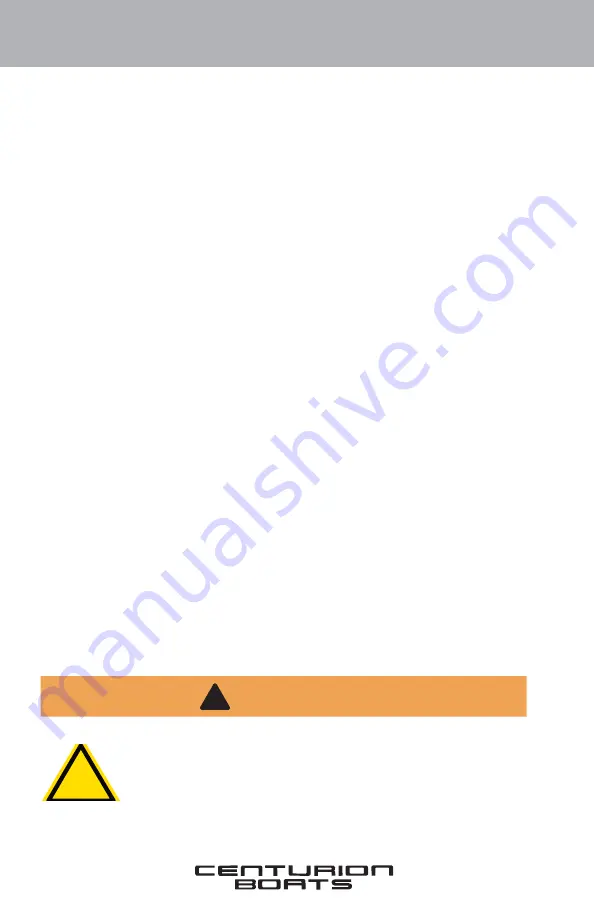
Section 3
3-14
With arms straight, and knees bent, let the boat pull you up and onto the water,
rather than pushing on the ski or leaning back against the pull.
What to do next:
After the driver and the skiers have their fill of casual skiing in
open water, try driving straight down the middle of a slalom course as the skier
swings back and forth around special turn buoys. It's addictive.
For more detailed and comprehensive instruction and additional ideas, visit: Basic
Skills Challenge series:
http://www.usawaterski.org/basicskillschallengeseries.htm
. Instructional articles
can be viewed at:
http://www.usawaterski.org/pages/instruction.html
.
Wakeboarding
Go anywhere, do anything in a pure adrenaline rush. There's always a fun new
move to learn. It's a sport you can make your own, by adding your own style to any
trick.
When wakeboarding, don't forget your:
•
Speed:
For the first time with kids, 12 mph; around 18-24 mph for adults.
Accelerate slightly if you need to adjust the wake so that it has a clean edge (not
foamy) near the front foot of the rider.
•
Line length:
65 feet is a good length for beginners, who will appreciate being
back where the wakes are softer and farther apart, though many riders start at
around 50 feet (the shorter rope length can make it easier to get up). More
experienced riders may want to be at about 75-80 feet, where the wakes are
more defined and wider.
•
Driving tips:
Drive straight to establish consistent wakes for the rider to enjoy.
The observer should always be facing the rider so the driver can focus on that
path and the speed. Slow but steady acceleration is best for wakeboarding
•
Ballast:
Factory-installed systems allow you to safely add hundreds of pounds
of water weight in ideal spots on the boat and shape the wakes for each rider's
preference. Weigh down the stern equal to the bow to best maintain your boat's
handling, taking into account passenger seating. A water-filled ballast bag is the
best way to add weight. DO NOT USE ballast that sinks, such as a bucket of
concrete, or lead.
!
WARNING
OVERLOADING HAZARD
Empty the ballast system before trailering your boat. The
extra weight of ballast water may overload the capacity of
your trailer and cause an unsafe condition that can lead to an
accident, injury or death.
!
Copyright 2019
Ken Cook Co.
All Rights Reserved
www.KenCook.com/marine
Summary of Contents for Fi21
Page 1: ...Centurion_Cover_2019_Layout 1 10 24 2018 9 48 AM Page 1...
Page 3: ...This Page Intentionally Left Blank...
Page 7: ...iv This Page Intentionally Left Blank...
Page 17: ...Section 1 1 10 This Page Intentionally Left Blank...
Page 27: ...Section 2 2 10 This Page Intentionally Left Blank...
Page 48: ...Safety 3 21 Figure 3 4 Figure 3 4 CNTRN 0050B A...
Page 68: ...Safety 3 41 Figure 3 10Centurion Ri237 Figure 3 13 Figure 3 11Centurion Ri217 Figure 3 14...
Page 69: ...Section 3 3 42 Figure 3 12Centurion Fi25 Figure 3 15 Figure 3 13Centurion Fi23 Figure 3 16...
Page 70: ...Safety 3 43 Figure 3 14Centurion Fi21 Figure 3 17...
Page 71: ...Section 3 3 44 This Page Intentionally Left Blank...
Page 131: ...Section 8 8 24 Fi23 Ballast Tank Locations Figure 8 22 Fi21 Ballast Tank Locations Figure 8 23...
Page 165: ...Section 10 10 10 This Page Intentionally Left Blank...
















































